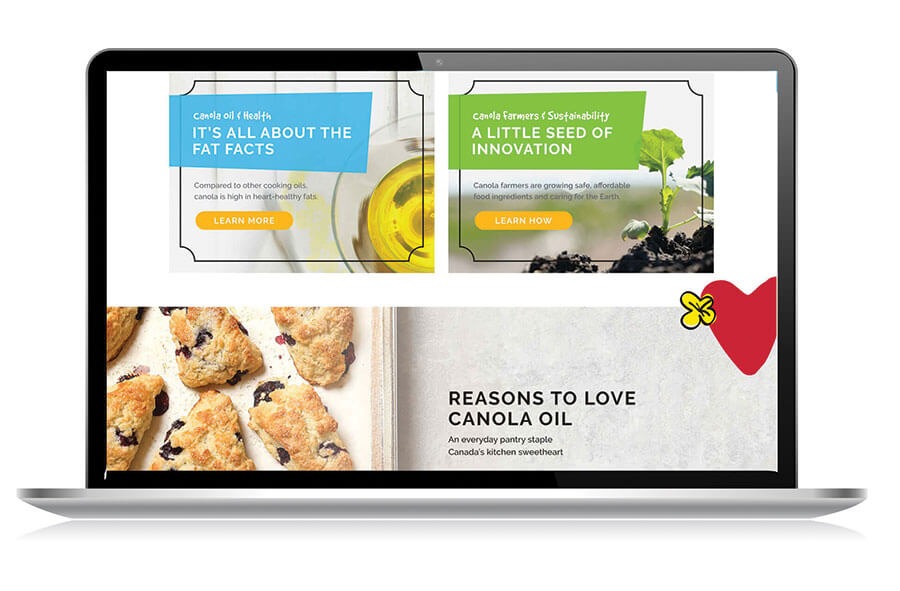Canola oil – healthy and so much more
“We needed a place where we could showcase the full Canadian canola story for Canadians. Now you can not only learn about reasons to love canola for your kitchen and health, but also the good news sustainability story of our farmers. There’s even space to expand on the ‘Flower Power’ of the crop through discussion on biofuels, canola meal and more,” says Jennifer Dyck, market development manager and Canola Eat Well lead for Manitoba Canola Growers. “This site is for Canadian consumers. Language and images have been carefully chosen and will continue to be updated as we learn more about how to best connect with those outside our industry.”
Canola Eat Well is a joint program funded by SaskCanola, Alberta Canola and Manitoba Canola Growers, with the mandate to increase Canadian demand for canola through market development activities.
The website at canolaeatwell.com takes a new approach to the question, “What is canola oil?,” providing the following answers.
“This site is for Canadian consumers. Language and images have been carefully chosen and will continue to be updated as we learn more about how to best connect with those outside our industry.”
—Jennifer Dyck
It’s truly Canadian
Canola is a true “Made in Canada” success story and the foundation of a thriving, sustainable industry. Canola is one of the most widely grown crops in Canada. Most canola grown in Canada is Brassica napus species, part of the large Brassicaceae family that includes mustard, cabbage, broccoli, cauliflower, turnip, kale and other healthy vegetables.
It’s supporting Canadian farmers
When you buy any bottle of canola oil, any size, any brand at any grocery store, you are supporting Canadian farmers. Canola brings diversity to the farm. As a cool season crop, it grows very well on the Canadian Prairies and in other parts of the country. It has become one of Canada’s most valuable agricultural exports and an important source of income for 43,000 Canadian farmers. More than 207,000 Canadian jobs are linked to canola – and the crop’s potential continues to grow. Renewable biofuels are the latest opportunity to expand uses for Canadian canola.

It’s healthy
Canola oil is low in saturated fat and the highest sources of plant-based omega-3 fats among all common cooking oils. At pennies per serving, this kitchen powerhouse is also easy on the wallet, making it great value for health. Canola meal, the solid part of the canola seed once the oil has been extracted, is used as a protein-packed feed for animals. While traditionally used only for animal feed, canola protein has the potential to offer nutritional benefits for humans as well.
Its future is bright
Canadian canola is used in biofuel production around the world because it’s a low carbon, sustainable and renewable resource in abundant supply. Biofuels are ready to use right now. That’s a clear advantage over other technologies requiring gradual adoption. When canola-based biofuels play a bigger role in Canada’s fuel supply, we will achieve real and immediate benefits for the environment, the economy and the whole canola value chain.
“Recipes remain a key driver to the Canola Eat Well website. The redesign is our opportunity to be more and to expand the story,” says Lynn Weaver, market development manager and Canola Eat Well lead for SaskCanola. “The fact that canola oil is a healthy choice for Canadians and a home-grown agriculture success story needs to be celebrated.”
Red flags to identify misinformation on social media
Social media is noisy, but can also be entertaining and informative. Sometimes you need to filter out the misinformation. Science and well-sourced content drives us at Canola Eat Well and if you find yourself out in the wild, here’s how to navigate the space and spot the junk. The International Food Information Council, based in Washington, D.C., hosted a webinar in October called “Navigating Nutrition Science in the Media.” One presenter, Charlotte Martin, a registered dietitian, described obvious red flags when it comes to spotting nutrition misinformation on social media. Posts with misinformation often:
- blame a specific food for the chronic disease we see today, and strongly encourage you to eliminate it from your diet. Big ones are gluten, dairy, soy, added sugar and seed oils
- use words like clean, toxic and chemicals in their posts
- strongly encourage people to choose organic as healthier than conventional
- push a distrust in conventional medicine and those with formal nutrition education, and frequently mention “big Pharma” and “big ag”
- preach eating whole, unprocessed foods but also sell their own line of supplements
- are often defensive, aggressive and can’t admit when they’re wrong
- use fear mongering to frighten people into action
- don’t have credentials. However some with health care credentials will make posts with other red flags.
- speak in absolutes and extremes – they say “never” “eliminate” “prevent” instead of “may help” or “may prevent”
- use popular buzzwords and phrases. Lately, these include inflammation and hormone balancing.
For more from the International Food Information Council, go to ific.org and foodinsight.org.





